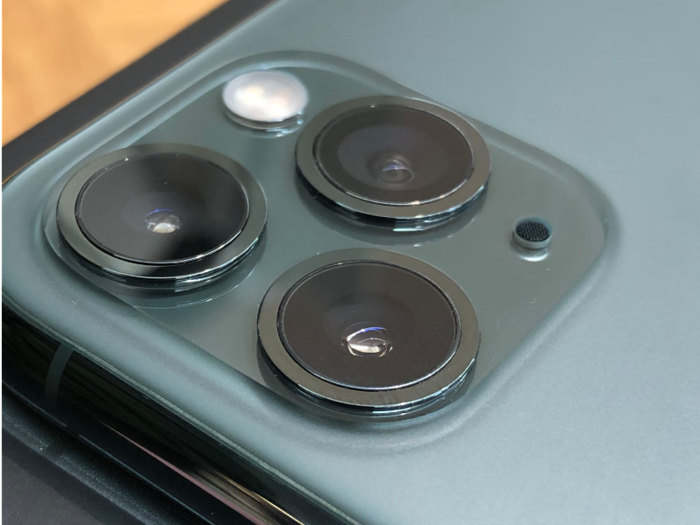
The Razr's front-facing camera only has a 5-megapixel sensor, which is a far lower resolution than that of other high-end smartphones like the iPhone 11 Pro or Samsung Galaxy S10. All three of Apple's new iPhones, for example, have a 12-megapixel selfie camera, while all the phones in Samsung's Galaxy S10 family have a 10-megapixel front camera.
But more importantly, the primary camera on the back of the Razr, the one you'll probably use to take the majority of your photos, only has one 16-megapixel lens. That may not sound like a shortcoming, but Motorola is putting a single lens camera on an expensive smartphone at a time when triple-lens cameras are quickly becoming the norm.
Both the iPhone 11 Pro and Samsung Galaxy S10, for instance, have wide-angle, telephoto, and ultra-wide-angle cameras that allow for more flexibility when shooting with your smartphone. I've found the ultra-wide-angle lens on the iPhone 11 Pro and Galaxy S10 to be especially useful, considering it makes it possible to squeeze much more of the scene into a frame than smartphones of years past. It's a useful feature I'd sorely miss if I ever try switching to the Razr.

That might not be very important right now, considering 5G networks are far from being available on a widespread basis. But if you're investing $1,500 in a new phone, you'll probably want to hold onto it for at least three years. By not supporting 5G, the Razr could quickly feel out of date.

The iPhone 11 Pro and Samsung Galaxy S10 both look like a bargain compared to the $1,500 Razr: the iPhone 11 Pro starts at $1,000, while the larger Pro Max starts at $1,100, and the Galaxy S10 starts at $900. The highest configuration of the iPhone 11 Pro Max, which offers a 6.5-inch display and 512 GB of storage, is still $50 cheaper than the Razr at $1,450. It has four times the amount of storage space compared to the Razr and a larger screen, in addition to a triple-lens camera and higher-resolution selfie camera.

The Razr's main selling point is that it can fold in half, making it much easier to stow away in a pocket or purse. That level of convenience is important considering today's smartphones are larger than ever.
But beyond making your smartphone more portable — and bringing back the ability to snap your phone shut to hang up on someone — it doesn't look like there will be much that makes using the Razr different than any other smartphone.
The Galaxy Fold, despite the durability issues it faced earlier this year, at least made it possible to do more with your phone. I loved using the Fold to expand the size of my phone's screen, making everyday tasks like playing a game, watching Netflix, or even just reading email feel more enjoyable. It made me hopeful for a future in which buying one device that serves as both a phone and a tablet felt like a viable option for most people

It's exciting to see smartphones that experiment with new designs and form factors, and doing so is necessary to keep pushing the industry forward. But it's also worth considering that purchasing a first-generation product is always a risky move. Since it's Motorola's first foldable phone, and one of the first foldable phones period, there's no telling how well it's going to hold up over time.
No one would have guessed that the screen on Samsung's Galaxy Fold was prone to issues, but then several reviewers reported that the display malfunctioned after only a couple of days of use. The Razr's screen has a protective scratch-resistant coating, and the device has a zero-gap hinge that should protect the display from debris. These measures will hopefully ensure that the Razr isn't prone to damage as the first version of the Fold was, but it's impossible to know for sure without using it.

You could argue that I'm missing the point by picking apart the Razr's technical specifications and zeroing in on the features it doesn't have. The Razr isn't meant to be like the iPhone 11 Pro or Samsung Galaxy S10.
You're paying a premium to get a one-of-a-kind phone with a foldable screen that has the look and feel of the cellphone you probably had back in 2005. Even if you didn't have the Razr, you probably had a flip phone of some kind, and the new Razr is designed to emulate that experience with a modern twist.
But it comes at a high price, just like the original. And in an era in which we rely on our phones for a lot more than we did back in the early 2000s, you'll have to decide whether it's worth the trade-offs.
 Colon cancer rates are rising in young people. If you have two symptoms you should get a colonoscopy, a GI oncologist says.
Colon cancer rates are rising in young people. If you have two symptoms you should get a colonoscopy, a GI oncologist says. I spent $2,000 for 7 nights in a 179-square-foot room on one of the world's largest cruise ships. Take a look inside my cabin.
I spent $2,000 for 7 nights in a 179-square-foot room on one of the world's largest cruise ships. Take a look inside my cabin. An Ambani disruption in OTT: At just ₹1 per day, you can now enjoy ad-free content on JioCinema
An Ambani disruption in OTT: At just ₹1 per day, you can now enjoy ad-free content on JioCinema Sustainable Waste Disposal
Sustainable Waste Disposal
 RBI announces auction sale of Govt. securities of ₹32,000 crore
RBI announces auction sale of Govt. securities of ₹32,000 crore
 Catan adds climate change to the latest edition of the world-famous board game
Catan adds climate change to the latest edition of the world-famous board game

Copyright © 2024. Times Internet Limited. All rights reserved.For reprint rights. Times Syndication Service.